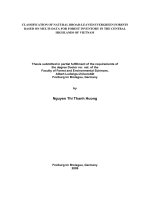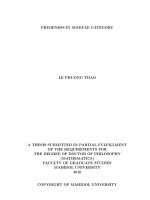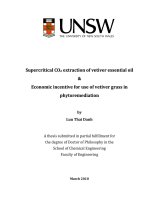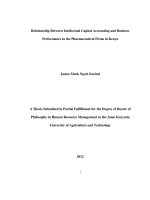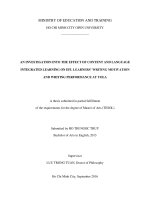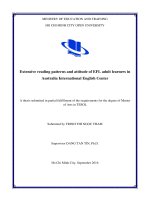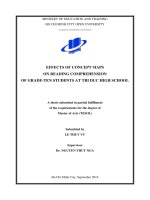thesis submitted in partial fulfillment of the requirements of the degree doctor rer nat
Bạn đang xem bản rút gọn của tài liệu. Xem và tải ngay bản đầy đủ của tài liệu tại đây (9.15 MB, 184 trang )
CLASSIFICATION OF NATURAL BROAD-LEAVED EVERGREEN FORESTS
BASED ON MULTI-DATA FOR FOREST INVENTORY IN THE CENTRAL
HIGHLANDS OF VIETNAM
Thesis submitted in partial fulfillment of the requirements of
the degree Doctor rer. nat. of the
Faculty of Forest and Environmental Sciences,
Albert-Ludwigs-Universität
Freiburg im Breisgau, Germany
by
Nguyen Thi Thanh Huong
Freiburg im Breisgau, Germany
2009
Name of Dean: Prof. Dr. Heinz Rennenberg
Name of Supervisor: Prof Dr. Barbara Koch
Name of 2
nd
Reviewer: Prof. Dr. Dr. h. c. Dieter R. Pelz
Date of thesis defence: 2
nd
December 2009
i
Abstract
Proper technical solutions of forest classification and forest mapping are essential to meet
the requirements for sustainable forest management planning with reasonable costs and in
a rational time period. The main focus of this study is to combine remotely-sensed data and
terrestrial data in classifying and mapping tropical forest. The current study also seeks to
describe which forest parameters are in closed relation with spectral data. Moreover, it also
addresses estimates of stand volume.
The study was conducted at a site on the Central Highland of Vietnam where much natural
forest remains. The research used SPOT 5 satellite imagery captured during February
2006. Geomatic and topographic corrections were carried out using ground control points
(GCPs) and Digital Terrain Model (DTM) which were obtained from Global Positioning
System (GPS) and contour lines, respectively. Three algorithms were tested for
topographical normalization, which are cosine, minnaert and C-correction. Satellite image
corrected using C-correction algorithm was used as input data for further analysis. Both
unsupervised and supervised methods have been integrated in the classification process. A
set of sample plots and sample points were collected for the classification and validation
during ground survey. The study recognized four major distinguished natural forest classes
and four non-forest land cover classes. A total of one hundred and twenty one sample plots
were collected from four forest classes for analysis. Diameter breast height (DBH), tree
height, crown diameter and distance to the nearest neighbor tree were measured by forest
inventory tools, while the others such as canopy cover and vegetation cover were estimated
visually. The regression method was employed to simulate the relationship amongst forest
variables, and between forest variables and spectral data. Tree density, mean diameter and
density of the trees having DBH ≥ 35cm were the important variables having a closed
relation with spectral values. Inverse J-shaped distribution Meyer N-DBH was selected as
the basis to calculate mean characteristics of individual forest class. Finally, an improved
classification system of natural wooden forest was defined based on the result of image
classification and mean value of forest conditions of quantitative criteria along with
qualitative characteristics. Four band SPOT5, three Principle Component (PCs), and a
Normalized Difference Vegetation Index (NDVI) image, and the methods of regression,
kNN and geostatistics were used to predict the forest stand volume. The best result was
obtained by applying regression kriging method on SPOT5 image. In order to predict
potential risk for the forest at the study area, the factors which related to accessibility in
forest utilization were also analyzed. These factors were divided into four different impact
ii
levels for the two relevant classes for better forest management. A thematic map showing
the potentially vulnerable sites was developed for forest management and planning.
For the monitoring purposes as well as for sustainable forest management of the
Vietnamese forests, a combination of remote sensing data and field inventory to produce
suitable classified forest maps is a prerequisite. In combination with the appraisal of
potential risks to forest stands, this information is of extreme importance for forest
planning activities.
iii
Zusammenfassung
Für die nachhaltige Bewirtschaftung von Wäldern sind forstliche Karten mit einer
zweckmäßigen Waldeinteilung von großer praktischer Bedeutung. Um diese wichtige
Datengrundlage zu erstellen und fortzuführen müssen geeignete technische Lösungen
gefunden werden, welche Kosten und zeitlichen Aufwand in vernünftigen Grenzen zu
halten. In dieser Arbeit wird nach einer optimierten Verknüpfung von
Fernerkundungsdaten und terrestrisch erhobenen Daten für die flächige Klassifizierung
von tropischen, naturnahen Wäldern gesucht. Dabei wird auch der Frage nachgegangen,
welche forstlichen Parameter eine enge Beziehung zu den spektralen Werten in den
Satellitendaten haben. Des Weiteren wurden Untersuchungen zur Schätzung der
Holzvorräte durchgeführt.
Das Untersuchungsgebiet liegt im zentralen Hochland von Vietnam. Dort kommen noch
verbreitet natürliche tropische Wälder vor. Als Fernerkundungsmittel wurde eine SPOT 5
Szene vom 5. Februar 2006 verwendet. Für die geometrischen und topographischen
Korrekturen des Satellitenbildes wurden Passpunkte (Ground Control Points) aus GPS
Messungen sowie ein Geländemodell aus digitalisierten Höhenschichtlinien eingesetzt. Für
die topographische Normalisierung wurden drei verschiedene Algorithmen getestet und
zwar Cosine, Minnaert und C-correction. Die besten Ergebnisse lieferte die C-correction,
weshalb diese Ergebnisse in die weiteren Verarbeitungsschritte einflossen. Die
vorbearbeiteten Satellitendaten wurden sowohl mit unüberwachter Klassifizierung, als
auch mit überwachten Klassifizierungsverfahren ausgewertet. Für letzteres und auch für
die Genauigkeitsüberprüfung der Ergebnisse wurden eine Reihe von Trainingsgebieten in
dem Untersuchungsgebiet festgelegt. Insgesamt 120 Plots wurden im Gelände angelegt,
verteilt auf die vier unterschiedenen, natürlichen Waldklassen sowie für vier weiteren
Landbedeckungsklassen. In den Plots wurden forstliche Parameter wie BHD, Baumhöhe,
Kronendurchmesser, Position der Bäume und deren relative Lage zu den Nachbarbäumen
gemessen, Kronenschluß und Bedeckungsgrad wurden geschätzt. Zur Berechnung der
Zusammenhänge zwischen den erhobenen forstlichen Variablen selbst sowie den
Variablen und den spektralen Fernerkundungsdaten wurden Regressionsanalysen
angewandt. Dabei wurden enge Zusammenhänge zwischen spektralen Eigenschaften mit
der Dichte des Kronendaches, dem mittleren Durchmesser, sowie der Dichte aller Bäume
über 35 cm Durchmesser gefunden. Für die Berechnung von charakteristischen spektralen
Eigenschaften der einzelnen Waldklassen wurde J-shaped Verteilung Meyer N-BHD zu
Grunde gelegt. Basierend auf den Ergebnissen der Satellitenbildklassifikation und den
berechneten Kennziffern wird in einem letzten Schritt ein neues, verbessertes
Klassifikationsschema für natürliche tropische Wälder in vorgeschlagen. Für die Schätzung
des Holzvorrates wurden die vier Kanäle der Spot 5 Szene, drei Principle Component
Berechnungen sowie der Normalized Difference Vegetation Index (NDVI) herangezogen.
iv
Dabei kamen verschiedene Methoden aus der Geostatistik, Regressionsanalyse und kNN
vergleichend zur Anwendung. Die besten Ergebnisse erzielte der geostatistische Ansatz
des „Regression Krigings“ mit den SPOT 5 daten. Als zusätzliche Information wurde das
potentielle Risiko für ungeregelte Waldnutzungen in Abhängigkeit von der Zugänglichkeit
der Waldflächen modelliert. Vier abgestufte „Impact“ Klassen wurden für die zwei
betroffenen Waldformationen mit GIS Techniken ausgeschieden. Die daraus resultierenden
thematischen Karten zeigen die gefährdeten Flächen und dienen für die Planung
entsprechender Maßnahmen bei der Waldbewirtschaftung.
Sowohl für Beobachtung der Waldentwicklung als auch für die nachhaltige
Bewirtschaftung der Wälder Vietnams werden durch die Kombination von
Fernerkundungsdaten und Feldaufnahmen sehr brauchbare Forstkarten zur Verfügung
gestellt. In Verbindung mit der Abschätzung potentieller Risiken sind diese ein
Planungsinstrument von großer praktischer Bedeutung für die Forstwirtschaft in Vietnam.
v
Acknowledgements
First of all, I would like to express my deep appreciation to Professor Dr. Barbara Koch
and Dr. Claus-Peter Gross of the Depatement of the Remote Sensing Lanscape Information
Systems (Felis) of the Albert Luwig University Freiburg for their kind supervision,
guidance and support. I also thank Prof. Dr. Dr. h. c. Dieter R. Pelz of Department of
Forest Biometry for his valuable comments and for taking up the role of co-referent of this
study.
The warmest thanks go to Assoc. Prof. Dr. Bao Huy, who has been giving me valuable
suggestions and kind assistance during my research. I wish to thank Mr. Sandeep Gupta,
Mr. Johannes Heinzel and Dr. Fillip Langa for their technical support.
My special gratitude goes to forest staff in Quang Tan forest enterprise, farmers, lecturers
and forestry students from Tay Nguyen University for their kind assistance during field
work. Without their support it would not have been possible to conduct such an extensive
forest inventory.
I would like to give my thanks to the Government of Vietnam for granting me the
scholarship and research subsidy support by the DAAD (German Academic Exchange
Service). I am also greatly indebted to the OASIS for providing remote sensing images.
I would like to express my sincere appreciation to all of the friends and colleagues of Felis,
Freiburg University, Germany and Department of Forest Resource and Environment
Management, Tay Nguyen University, Vietnam for their kind assistance during my
research.
Last but not least, my deepest thanks go to my family for their patience, support and
encouragement throughout my many years of higher education. My parents have been an
endless source of love and understanding throughout my life. My husband, daughter,
brothers and sisters have always given me all their infinite love and best wishes. To all I
am grateful for their roles in my life.
Nguyễn Thị Thanh Hương
vi
Table of Contents
Abstract i
Zusammenfassung iii
Acknowledgements v
List of Tables xi
Illustrations xiii
List of Abbreviation xv
1 INTRODUCTION……………………………………………………….1
1.1 Background
1
1.2 Problem analysis
3
1.3 Objectives 7
1.4 Hypothesis 8
1.5 Outline 8
2 FOREST CLASSIFICATION SYSTEM…………………………….10
2.1 The forest classification
systems 10
2.2 The classification syste
ms of forest in Vietnam 13
2.2.1 Several forest classification systems before 1975 13
2.2.2 The developed classifications in the post-war period 14
3 MULTI-DATA SOURCES IN FOREST INVENTORY…………….19
3.1 Remote sensing techn
iques 19
3.1.1 Pre-processing remote sensing images 19
3.1.2 Image processing 22
3.1.3 Normalized Difference Vegetation Index (NDVI) 27
vii
3.1.4 Principle component analysis (PCA) 28
3.2 Forest para
meter considerations 29
3.2.1 Definiton of some forest characteristics 29
3.2.2 Regression analysis considered as the major double sampling among forest
parameters 30
3.3 Combining of remote sensing and te
rrestrial data 31
3.3.1 Multiphase sampling 31
3.3.2 Determining the sample size 33
3.3.3 Estimation of forest variable using remote sensing 33
3.4 GIS technique
36
3.5 Relation bet
ween relevant factors and forest status 37
3.6 Literature re
view 37
3.6.1 Classification of forest using remote sensing images 37
3.6.2 Prediction of forest parameters using remotely sensed data 38
4 DESCRIPTION OF RESEARCH AREA…………………………….43
4.1 Location
43
4.2 Topography 44
4.3 Geology an
d soil 44
4.4 Climate 44
4.5 Description
of forest types 45
4.6 Forest jurisd
iction 46
5 METHODOLOGY…………………………………………………… 48
5.1 Data, Software and equipment
49
5.1.1 Data availability 49
5.1.2 Software 51
viii
5.1.3 Equipment and tools 51
5.2 Developme
nt of a set of field data 52
5.2.1 Pre-field preparation 52
5.2.2 Field measurement 53
5.2.3 Statistical approach to field data survey 54
5.3 Pre-processing remote sensing data
56
5.3.1 Ortho-rectification 56
5.3.2 Topographical correction 57
5.4 Multispectra
l classification 60
5.4.1 Unsupervised classification 60
5.4.2 Supervised classification 60
5.4.3 Accuracy assessment 63
5.5 Statistical d
escription of forest classes 65
5.5.1 Transformation of data 65
5.5.2 Regression analysis technique 66
5.6 Estimation of stand volume by different methods
67
5.6.1 Using empirical regression 67
5.6.2 The k-NN algorithm 68
5.6.3 Geostatistics with regression kriging 69
5.6.4 Model evaluation 72
5.7 Assessing
risk potential of forest status by indirect factors for forest management
………………………………………………………………………………………… 73
5.7.1 Basis of assessment 73
5.7.2 An analysis based on database and forest map 74
6 RESULTS……………………………………………………………….77
ix
6.1 Topographic correction 77
6.2 Statistical a
pproach with stand forest variables 78
6.2.1 Height – Diameter Relationship (H - DBH) 78
6.2.2 Volume equation for forest stands 80
6.3 Proposal for
a new forest classification system based on both quantitative and
qualitative criteria of the stand 80
6.3.1 Average characteristics of each forest status 80
6.3.2 Estimates of forest stand parameters 81
6.3.3 Qualitative description as a definition of the forest class 85
6.4 Forest/land cover
classification 86
6.4.1 Forest/Land cover map 86
6.4.2 Natural broad-leaved evergreen forest 88
6.4.3 Plantation forest 90
6.4.4 Bamboo 90
6.4.5 Shrub/Grass land 90
6.4.6 Other lands 91
6.5 Accuracy assessment
91
6.6 Relation of
directly surveyed data with spectral images 92
6.6.1 Correlation Analysis 92
6.6.2 Relationship model 96
6.7 Estimation of stand volume from spe
ctral image and field data survey 96
6.7.1 Regression method 96
6.7.2 KNN method 101
6.7.3 Geostatistical method with regression kriging 102
6.7.4 Accuracy assessment of the models 105
x
6.8 Involvement of relevant factors in forest management 106
6.8.1 Risk potential of poor forest status from disturbance 106
6.8.2 Potential risk from clearing forest for agricultural land 109
7 DISCUSSION…………………………………………………………113
7.1 Improve
ment of the existing classification system based on satellite images 113
7.2 Relation of stand volume
and image data 116
7.3 Relevant factors in the categorizatio
n of forest for better management and
planning 121
8 CONCLUSION……………………………………………………… 122
8.1 Important research find
ings 122
8.2 Limitations
of the study 123
8.3 Recommen
dations and future outlook 124
References 127
xi
List of Tables
Table 2.1 Classification system of forest developed by Thai Van Trung (1978, 1999) 14
Table 2.2 Class definition for Vietnamese Classification of Evergreen Natural Wooden
Forest 15
Table 5.1 Characteristics of SPOT 5 image 50
Table 5.2 Description of land cover and their appearance on SPOT-5 image 61
Table 5.3 Interpretation of Kappa Values 64
Table 5.4 Relevant factor classes indirectly affect forest status 74
Table 6.1 The regression between digital value with incidence angle 77
Table 6.2 Result of homogeneity test 81
Table 6.3 The mean forest characteristics of forest status 82
Table 6.4 Density and basal area of mature trees 82
Table 6.5 Description of forest class 85
Table 6.6 The land cover area in ha and percentage 87
Table 6.7 Confusion matrix of the Maximum Likelihood classification 92
Table 6.8 Pearson’s correlation pairs of variables 93
Table 6.9 Pearson correlation matrix for forest variables and classified forest classes 95
Table 6.10 Pearson correlation matrix for the variables analyzed for stand volume
estimation 97
Table 6.11 Results of simple regression modeling for stand volume 98
Table 6.12 Results of simple regression modeling for logarithmic stand volume 98
Table 6.13 Error of the volume estimates using three different methods 105
Table 6.14 Risk levels based on relevant factors from poor forest 109
xii
Table 6.15 Risk levels based on relevant factors from agricultural land 112
Table 7.1 Correlation of spectral data and stand volume characteristics 117
xiii
Illustrations
Figure 1.1 Problem Analysis Tree 6
Figure 1.2 Main concerns of the thesis 7
Figure 2.1 Vietnamese classification of evergreen natural forest 15
Figure 4.1 Location of study area 43
Figure 4.2 Rate of the main land cover 46
Figure 4.3 Rate of the forest categories 46
Figure 5.1 Main approach 49
Figure 5.2 Equipment for stem diameter and tree height measurement
52
Figure 5.3 A common semivariogram form 70
Figure 5.4 A schematic example of regression-kriging: fitting a vertical cross-section with
assumed distribution of
an environmental variable in horizontal space 72
Figure 6.1 SPOT 5 False Colour Image 78
Figure 6.2 Scattergram of the relationship between tree height and breast height diameter
79
Figure 6.3 Inverse J-shaped distribution Meyer N-DBH 84
Figure 6.4 Land cover classification map 87
Figure 6.5 Rate of land cover classes 88
Figure 6.6 Volume map using SPOT 5 image and regression estimator 100
Figure 6.7 Volume map using SPOT 5 image and kNN method 101
Figure 6.8 Histogram of original and log transformed volume 102
Figure 6.9 Experimental variogram with fitted model, log (volume) 103
Figure 6.10 Volume map using SPOT 5 image and regression-kriging method 104
Figure 6.11 Accuracy assessment of standing volume estimations 106
xiv
Figure 6.12 Relation of poor forest area with (a) distance to stream, (b) elevation and (c)
slope level 107
Figure 6.13 Map of risk potential from poor forest status 108
Figure 6.14 Relation of agricultural land area with (a) distance to stream, (b) elevation and
(c) slope lev
el 110
Figure 6.15 Map of risk potential from agricultural land 111
Figure 7.1 Exponential negative relationship of stand volume and band 2 118
Figure 7.2 Stem volume (x-axis) plotted against estimated stem volume (y-axis)
using (a) re
gression function, (b) regression-kriging with 4bands SPOT 5, (c) regression-
kriging with PCs, (d) regression-kriging NDVI, (e) kNN with 4bands SPOT5, (f) kNN with
PCs and (g) kNN with NDVI 120
Figure 8.1 Applicability of the study in practice 126
xv
List of Abbreviation
BA Basal area
BA
DBH35
Basal area of tree having DBH equal to 35cm and over
C Celsius
Ca.co Canopy cover
Veg.co Vegetation cover
CPU Central processing Unit
Cr.A Crown Area
DBH Diameter at Breast Height
DEM Digital Elevation Model
Dis. to NN tree Distance to nearest neighbor tree
DN Digital Number
e.g. for example
Eq. Equation
ETM+ Enhanced Thematic Mapper Plus
FD Forestry Department
FAO Food Agricultural Organization
GCP Ground Control Point
GoVN Government of Vietnam
GIS Geographic Information System
GPS Global Position System
H Tree height
HRS High Resolution Stereoscopic
ISODATA Iterative Self – Organization Data Analysis
kNN k Nearest Neighbor
LAI Leaf Area Index
MARD Ministry of Agricultural Rural Development
MLC Maximum likelihood classifier
MSS Multi Spectral Scanner
N Tree density
N
DBH35
Density of tree having DBH equal to 35cm and over
NDVI Normalized Difference Vegetation Index
NIR Near Infrared Region
PCA Principal Component Analysis
PC Principal Component
xvi
RK Regession - kriging
RMS Residual Mean Square
RMSE Root Mean Squared Error
SD Standard Deviation
SPOT Satellite Pour l’Observation de la Terre
SPOT XS Satellite Pour l’Observation de la Terre
SWIR Short-wave Infrared Region
TM Thematic Mapper
UNESCO United Nations Educational, Scientific and Cultural Organization
USGS United State Geological Survey
UTM Universal Transverse Mercator
WGS 84 World Geodetic System 1984
1
Chapter I
1 INTRODUCTION
1.1 Background
Forest mapping is one of the most important factors for organization of forest resource
inventory and monitoring. With forest mapping, a classification of the forest in
homogenious strata is carried out as a basis for sustainable forest management plans.
The main purpose of the classification of forest type is to support forest management
planning. The classification should be based on needs of potential resources, forest
characteristics with up-to-date information using the minimum time necessary and at a
reasonable cost. Therefore, the definition of a forest ecosystem and the relevant
characteristics vary with the resource managed and the issue under consideration (Wulder
and Franklin, 2007). The role of classification is to provide a set of criteria that bring a
certain degree of order to ecological community patterns. A classification system has been
developed to address a wide variety of spatial scale and purpose, therefore, a suitable
classification system is not only important for management planning but also for forestry
development strategy. The system can be directly interpreted from imagery and can be
associated with the ground information as well as the ancillary information with an
acceptable accuracy. According to Franklin (2001), the use of remote sensing in
classification is based on the fact that the differences on the ground between vegetation
types can be isolated or separated as differences in the image characteristics. When
different vegetation structures define the classes, and the latter correspond with
recognizable vegetation types on the ground, there is a good reason to believe that the
types can then be mapped with digital remote sensing data and methods (Merchant, 1981).
The goal of remote sensing in forestry is the provision, based on available or purposely
acquired remote sensing data, of information that foresters need to accomplish the various
activities that comprise sustainable forest management. The objective of classification is to
generate spatially explicit generalizations that show individual classes selected to represent
different scales of forest organization (Franklin, 2001). Of all the available ways of
extracting information from remote sensing data, image classification in particular can be
considered as a prime candidate for a standard methodology with the potential to be
distilled into a protocol that can be extended spatially and temporally (Lillesand, 1996).
2
In forestry, as in many other disciplines involving land management, there exists a definite
need for timely, reliable information on which to base resource management decisions
(Fleming and Hoffer, 1979). Hence, effective policy decisions aimed at protection and
sustainable use of forest lands need to be based on reliable, accurate and relevant
information (Stibig et al., 2003).
A suitable classification system will aid in the large management context while
assessments of forest structure and status are of fundamental importance to forest
management. The purpose of traditional forest inventory is to provide unbiased and
reliable forest resource information. Typically these inventories lack fine spatial resolution
and even performed teresstrially only. In recent decades, however, remote sensing, the
Global Positioning System (GPS), and Geographic Information Systems (GIS) have
provided new opportunities for such forest inventories. Integrating these techniques and
tererrestrial data as an analysis of multi-source information is therefore of particular value.
According to Franklin (2001), remote sensing and geographical information systems
(GISs) are more than tools to satisfy increasing information needs of resource managers.
They represent essentially new approaches to forest disturbance and spatial pattern
mapping and analysis because they enable new ways of viewing disturbances and
landscapes, which in turn influence our understanding and management practices.
Consideration of the fragmented status of forests is also necessary. There are several
reasons causing fragmentation, but largely forest fragmentation is caused by human
activities. Disturbances can be defined as relatively discrete events that disrupt ecosystem,
community or population structure, and change the availability of resources or the physical
environment (Pickett and White, 1985). Analysis of the disturbance regime of a forest can
be of great value for understanding patterns of structure and composition, as well as being
important for defining appropriate management interventions. Characterizing the
disturbance regime typically involves assessing the severity, timing, and spatial
distribution of the different types of disturbance affecting the forest (Newton, 2007).
Consequently, an understanding of the natural and societal dynamics also has great
implications for forest management. Knowing the factors which are related to forest
accessibility e.g. topography, accessibility to forest area and so on, and how they impact
natural resources in indirect manner may contribute to better forest management planning.
Although the great progress in remote sensing and GIS in recent decades has provided
considerable opportunities for improving the effectiveness of forest management, an
application of remote sensing in forestry in Vietnam is limited due to several reasons,
3
namely in technique and resources as well. Meanwhile, characteristics of natural
rainforests are specific and complex, and always be put under change by forest land
utilization and social pressures. Correspondingly, the traditional method in forest inventory
cannot satisfy increasing information requirements in a sustainable forest management
system. For this reason, a multi-source approach of combining remote sensing, GIS and
field data may improve effectiveness of forest management planning at the location.
1.2 Problem analysis
The forestry issues in Continental Southeast Asia are probably the most complex in the
world (Stibig, 2003). As in many Southeast Asian countries, Vietnam has experienced the
highest rates of net forest cover decline. Estimates of the change in forest cover in Vietnam
in the last half century vary greatly in measurement. The forests have dramatically
decreased overall during the last 60 years, despite having slightly increased recently. The
forest cover declined from 43% of the country’s area to 30% in 1985, and 28% in 1995
(Lung, 2001; Maurand, 1943). Especially in the war time, large areas of mangrove and
rainforests of Vietnam were eradicated by toxic chemicals (Nakamura, 2007). The
summary tally is that 104,909 ha of mangrove forests and about 3,000,000 ha of inland
forests were eliminated. The total defoliated area amounted to 3,104,000 ha. Some
82,830,000 cubic meters of wood were lost. Inland forests were converted into the fields of
tall grass with a strong, thick reticulate (Nakamura, 1995). The forests have continued to
decrease in area and degrade in quality during recent years. The forests have been
destroyed for many reasons, such as overexploitation, shifting cultivation, and agricultural
extension (Lung, 2001). However, Lang (2001) expresses that the key causal forces come
from the role of government and state forest enterprise such as resettlement programs,
migration and logging by state forest enterprises. Nevertheless, illegal logging is a serious
problem as it has annually destroyed around 30,000 ha of forests in recent decades (GoVN,
1994). In oder to raise forest cover, the 5 Million ha Reforestation Program was initiated in
1998 with a target to plant 5 million ha of forests by 2010, restoring the forest cover to
43% (MARD, 1998). The program aims not only to reforest, but also to protect existing
natural forests. As a result, the forest cover of Vietnam has gradually increased. In 2003,
the forested area of Vietnam was 12,094,518 ha, of which 10,004,709 ha were natural
forests and 2,089,809 ha were plantation forests, resulting in a forest cover of 36.1%
(Hung, 2004). However, the quality of forests is still low since most of the forests are poor
in timber volume and lack valuable species as a result of a long time of overexploitation
and random logging (Dang et al., 2001; Nguyen, 1997). It is reported that natural forests
4
rich in timber resources cover only 1.4 million ha (13%) while poor and young forests
comprise around 6 million ha (55%).
In this context, ensuring the sustainable use of the remaining forests has never been more
important. Nevertheless, it is evident that there is an uncertainty about the actual forest
resources in Vietnam (Bao, 2006). Approximate estimations of forest cover and the quality
of stand structure are also given for natural forests. Lack of modern techniques and multi
data sources and poor logistical support in forest resource assessment in Vietnam are the
main causes that lead to deceptive forest data creation. Consequently, there is a need for
reliable sources of data for natural forest resources.
Effective policy decisions aimed at protection and sustainable use of forest lands are
indispensable, therefore, accurate and relevant information to quantify and assess their
quality in terms of biophysical variables (i.e. diameter at breast height, stand height,
species composition, basal area, volume, tree density and age) are important. Knowing just
what forests are left, and where these are is a good starting point (Stibig et al., 2003). Thus,
a suitable classification of forests and mapping of forest cover to provide a comprehensive
and reliable view of the region’s forest cover is important to help forestry managers make
appropriate decisions in forest management and planning.
Several ecological classification systems have been developed for Vietnamese forests
during the past century in North and South Vietnam separately. In forest planning and
management, a common system, which came into force from the Vietnamese Government,
has been used since 1975 (see chapter II). This system was established for the whole
country without a region specific focus. The classification criteria of this system was
developed from basis of forest condition in the North region, then applied to the whole
country. As a consequence, this leads to not only difficulties in inventory but also in forest
management strategies.
Vietnam basically has a tropical climate as it lies inside the Northern Tropical Zone.
However, due to a varying monsoon season and complex terrain, the climate of Vietnam
differs with latitude and altitude (Lap, 1999; Thai, 1998). In other words, the climate
differs from the South to the North. Meanwhile, climate – hydrology is the decisive factor
group to physiognomy and structure of vegetation type. Forest types vary in general as a
function of environmental and climatic factors including temperature, rainfall, humidity,
seasonality - often governed by latitude and topography (Thai, 1978). As a result,
characteristics of vegetation vary not only in physiognomy but in structures from the North
5
to the South. Thus, to apply the classification system which was based on the forest
condition of the Northern Vietnam to the whole country is unsuitable, especially for the
forests distributed in the Central Highlands, because they have far different ecological
conditions from the North. In practice, this system has caused some issues while used in
inventory in the Central Highlands, namely:
- When the status is used for forest classification the factor of basal area or
volume is not homogeneous.
- In general, the forests in the Central Highlands are distributed on more
propitious land than that of the north. Hence, applying specific criteria of DBH,
crown closure, and species of this system as indicative parameters in
classification for Central Highlands forests is seemingly inappropriate.
- The classification criteria are mainly descriptive, making it difficult to specify
and distinguish in practice.
As presented alrealdy, one of the vital causes of ineffective management of the forests is
lack of spatial information resources. Thus, the combination of remote sensing data in
forest inventories has not been done, the forest data have not been frequently updated and
the forest maps are coarse. As a result, out-of-date forest information is the basis of forest
planning management. Consequently, erroneous decision-making is unavoidable.
Natural forests in the Central Highlands account for 50% of its land, in which areas of
natural broadleaved evergreen forests are dominant. However, a dynamic view of forests in
the Central Highland of Vietnam is necessary because primary forests disappeared almost
completely and were replaced by a mosaic of forest formations in varying degrees of
several kinds of degradations in the past. Daknong is one of the similar provinces that has
the most abundant forest resource in Vietnam. But, as in other provinces in the Central
Highlands, the forests in Daknong appear as a mosaic of different communities and
characteristics, distinct from others with respect to their structural parameters. However,
with the inflexible system for the aforementioned reasons, the forest management in the
Central Highlands in general, but in Daknong in particular, has encountered more difficulty
in forest resource assessment than other provinces as well as in forest management
planning. Therefore, adjustment of the countrywide classification system to the conditions
and requirements of specific area e.g. the Central Highlands, is necessary in forest
management and forest development strategy.
In addition, although the forests of tropical countries are very diverse in species and
complex in structures, they are being lost at an alarming rate. The most crucial underlying
6
cause of deforestation is due to highest population (people) growth rates in the world
(Laurance, 1999; Wright and Muller-Landau, 2006). Therefore, a successful forest strategy
requires not only a good understanding of the natural but also social conditions and their
relations to the strategy’s objectives. For this reason, assessment of accessibility to forest
resources is also one of the considerations under study.
The main problems as mentioned above are summarised in a diagram of cause and effect
relations, illustrated in Figure 1.1. The unsuitable forest classification system along with
drawback techniques in forest inventory are major causes leading to ineffective forest
management planning.
Figure 1.1 Problem Analysis Tree
7
Within limitation of time and scholarship as well as individual capacity, the three causes
which were rounded in diagram in Figure 1.2 were concerned in this study. The endeavors
to combine modern techniques (remote sensing and GIS) with terrestrial data were done to
improve these problems.
Inadequate Forest
Classification System in the
Central Highlands
Effects
Causes
Not popular RS and
GIS techniques
Unsuitable Forest
Classification System
Difference of natural forests of the
Central Highlands from other parts
in the Country
Mechanism for
application and updating
Lack of human
resource
Lack of finance
Limitation of education/
training in RS and GIS
Rapid change in forest status
in overtime
Uncontinuous update,
unconfident maps and
database
Linkage between RS +
GIS and Inventory
Time consuming, expensive
Be difficult classify forest
status in the field
Invaluable forest management
plans
Lack of reliable basic in
forestry development Strategy
Figure 1.2 Main concerns of the thesis
1.3 Objectives
Originating from the analysed problems above, the goal of the current study is to improve
existing classification by combining remote sensing and terrestrial data for forest
classification aim to ensure practicality and timeliness. The specific objectives of the
research are:
